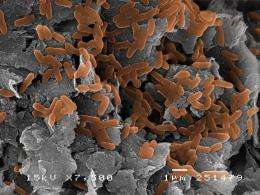June 6, 2012 report
Researchers show bacteria use natural materials to transfer electrons

(Phys.org) -- For years scientists have known that plants and animals transfer electrons between cells and because of that are able to consume food and use it to gain energy. They’ve also known that some microorganisms are able to transfer electrons between themselves and other organisms that are some distance apart. What’s not been known is how they do that. Now, a new study by a team of Japanese researchers has found that at least some bacteria use natural elements in the soil to transfer electrons and thus enable their survival. In their paper published in the Proceedings of the National Academy of Sciences, they describe how they recreated the process by which bacteria communicate over distances in their lab by adding magnetite to the soil which caused previously non-communicating bacteria to begin interacting over a small distance.
Scientists have speculated since the 1960’s that microorganisms are able to communicate with one another or other organisms though conductive material in soil, but until now, the idea was just theory. And just two years ago, researches in Denmark had found that microorganisms living in the sediment at the bottom of sea were somehow able to exchange electrons with those that live on the surface, which resulted in oxygen being made available for those in the sediment enabling them to survive.
In this newest research the team added two types of bacteria, Geobacter sulfurreducens and Thiobacillus denitrificans, to a sample of soil and then added acetate and nitrate, the food that the two microorganisms normally eat. But neither would do so. To help them out, the team mixed in the electrically conducting mineral magnetite. That spurred both into action. The idea is that neither of the two types of bacteria can eat without the ability to transfer electrons from one to another and magnetite is the conduit they use to accomplish that feat. To make sure their observations were correct, the team tried using the poor conductor rusted red iron and found the bacteria slowed their eating as a result. And when a non-conductor was mixed in instead, both stopped eating altogether.
The team speculates that based on their results it’s likely that many microorganisms communicate by passing electrons through soil, though one small detail still needs to be worked out. How can they rely on the conductive material to be spaced just right in the soil to allow for the passing of electrons? At this time no one is really sure, but some have suggested that it’s possible that the bacteria may actually cause so-called electrical grids to be built to allow them to communicate, though thus far there is no evidence to support the theory, intriguing as it may be.
More information: Microbial interspecies electron transfer via electric currents through conductive minerals, PNAS, Published online before print June 4, 2012, doi: 10.1073/pnas.1117592109
Abstract
In anaerobic biota, reducing equivalents (electrons) are transferred between different species of microbes [interspecies electron transfer (IET)], establishing the basis of cooperative behaviors and community functions. IET mechanisms described so far are based on diffusion of redox chemical species and/or direct contact in cell aggregates. Here, we show another possibility that IET also occurs via electric currents through natural conductive minerals. Our investigation revealed that electrically conductive magnetite nanoparticles facilitated IET from Geobacter sulfurreducens to Thiobacillus denitrificans, accomplishing acetate oxidation coupled to nitrate reduction. This two-species cooperative catabolism also occurred, albeit one order of magnitude slower, in the presence of Fe ions that worked as diffusive redox species. Semiconductive and insulating iron-oxide nanoparticles did not accelerate the cooperative catabolism. Our results suggest that microbes use conductive mineral particles as conduits of electrons, resulting in efficient IET and cooperative catabolism. Furthermore, such natural mineral conduits are considered to provide ecological advantages for users, because their investments in IET can be reduced. Given that conductive minerals are ubiquitously and abundantly present in nature, electric interactions between microbes and conductive minerals may contribute greatly to the coupling of biogeochemical reactions.
Journal information: Proceedings of the National Academy of Sciences
© 2012 Phys.Org















